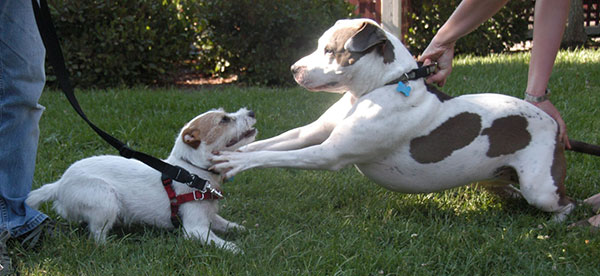
Dogs are at heart, wild animals. They long to romp and roam freely but for the safety of our dogs and others, we use leashes.
Leashes can cause frustration
When dogs are well-balanced and in unthreatening situations, they seldom show signs of aggression. But when confronted with pain or a threat to their safety, dogs might react with redirected aggression. This is when the dog bites or tries to bite something or someone other than the source of pain or frustration. Because the natural instinct in confrontation is fight or flight, dogs feel frustrated when tethered by a leash and unable to get away.
Dogs give warning signs
If you are walking a dog that seems alarmed or concerned by an approaching animal or oncoming situation, you will notice that your dog gives off body language to alert you to the frustration. Walking head-on toward the target or threat builds tension and if not handled correctly, the dog might bite you or another animal in redirected aggression. Professional dog trainer Dee Launder defines redirected aggression as a situation “when a dog directs (aggression) from a primary target to a secondary target”. The dog looks at the other dog or situation as the source of its frustration, but the frustration is really caused by the leash restraining the dog’s ability to escape the threat. Dogs are not able to distinguish between what causes pain and what they are focused on so dogs attack the closest thing when they reach their limit.
Know the signals
A dog’s instinct is to redirect its aggression, whether the secondary target is you or the dog walking alongside it. But the redirect comes only after the dog warns with body language. The dog stiffens and stares but does not look directly at the threat. This is called whale eye, which occurs when the dog’s eyes are looking in a direction other than the direction of the head. If the dog has a long tail, the tail stands up stiff or moves quickly – it “chatters”. A curly tail will uncurl slightly and a nub will stick straight out, according to Launder. Understand what the dog is trying to tell you when it attempts to get away from the situation by trying to get out of the collar or away from the leash. You might even see snarling or a lumpy whisker bed, which is a precursor to the snarl.
Provide an alternative
Launder suggests that the best option is to stop the dog from looking at the threat. Turn your dog at a 90-degree angle or in a circle so it isn’t staring at the oncoming animal. With proper training, you can teach your dog to avoid the instinct to become aggressive to a potential threat. Instead of fight or flight, you show the dog a better behavior. When the dog complies, stop and reward with praise then you can continue to walk away from the threat.
Earn your pet’s trust
Another critical component is that the dog must trust that the owner will get it out of the confrontation. Offer the dog an opportunity to follow a command and be praised. Launder says this is part of “training humans for dogs”, which is her tag line. She also encourages owners to use reassuring language in a pleasant tone to get the dog back to a relaxed and neutral state, but avoid baby talk and coddling. Dropping to your knees and petting the dog when it behaves inappropriately reinforces the behavior you wish to stop. Responsible dog walking requires that you notice your surroundings and your dog’s body language. Only then can you keep your dog, yourself and other innocent animals and people safe.




